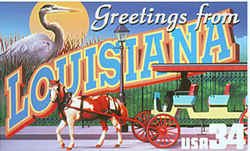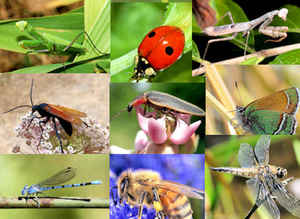
Louisiana Symbols
Louisiana State Insect
Honeybee

(Apis mellifera)
Adopted in 1977.
The honeybee, (Apis mellifera,) is a social, honey-producing bee, recognized as the most economically valuable of all insects. This reputation commonly rests on its production of honey and beeswax. The honeybee's greatest usefulness, however, is actually in the pollination of crops, including fruits, nuts, vegetables, and forage crops, and many uncultivated plants that prevent erosion by keeping topsoil from being carried into the ocean. The honeybee was made the official insect in 1977.
Did you know that: The honey bee has been proclaimed the official state insect in each of the following states:
Arkansas | Georgia | Kansas
| Kentucky | Louisiana
Maine | Mississippi |
Missouri | Nebraska | New Jersey
North Carolina | Oklahoma | South
Dakota | Tennessee
Utah | Vermont | West Virginia
| Wisconsin
Louisiana State Insect: Honeybee

Honey has been collected in Louisiana since before it became a state in 1812. In the 19th century, some of Louisiana's big plantations produced thousands of pounds of honey each year. Today, not only are thousands of pounds of honey collected every year in Louisiana, but queen bees bred in Louisiana are sent all over the United States to raise bee colonies.
The honeybee plays a vital economic role in Louisiana through its pollination of various crops, trees, and grasses. The honeybee is the only insect that can be moved for the express purpose of pollination.
Bees produce honey as food stores for the hive during the long months of winter when flowers aren't blooming and therefore little or no nectar is available to them. European honey bees, genus Apis Mellifera, produce such an abundance of honey, far more than the hive can eat, that humans can harvest the excess. For this reason, European honey bees can be found in beekeeper's hives around the world!
The taste, color and nutrient content of honey varies from place to place depending upon the kind of flora growing in the area. For example, Tupelo honey (from Tennessee) is twice as sweet as most honey. Many people take honey from their own neighborhood as a kind of natural antihistamine.
Honeybees probably originated in Tropical Africa and spread from South Africa to Northern Europe and East into India and China. They were brought to the Americas with the first colonists and are now distributed world-wide. The first bees appear in the fossil record in deposits dating about 40 million years ago in the Eocene. At about 30 million years before present they appear to have developed social behavior and structurally are virtually identical with modern bees.
Characteristics of the Honeybee
Colony:
Honey bees are social insects, with a marked division of labor between the various types of bees in the colony. A colony of honey bees includes a queen, drones and workers.
The Queen:
The queen is the only sexually developed female in the hive. She is the largest bee in the colony.
A two-day-old larva is selected by the workers to be reared as the queen. She will emerge from her cell 11 days later to mate in flight with approximately
18 drone (male) bees. During this mating, she receives several million sperm cells, which last her entire life span of nearly two years.
The queen starts to lay eggs about 10 days after mating. A productive queen can lay 3,000 eggs in a single day.
The Drones:
Drones are stout male bees that have no stingers. Drones do not collect food or pollen from flowers. Their sole purpose is to mate with the queen. If the colony is short on food, drones are often kicked out of the hive.
The Workers:
Workers, the smallest bees in the colony, are sexually undeveloped females. A colony can have 50,000 to 60,000 workers.
The life span of a worker bee varies according to the time of year. Her life expectancy is approximately 28 to 35 days. Workers that are reared in
September and October, however, can live through the winter.
Workers feed the queen and larvae, guard the hive entrance and help to keep the hive cool by fanning their wings. Worker bees also collect nectar to
make honey. In addition, honey bees produce wax comb. The comb is composed of hexagonal cells which have walls that are only 2/1000 inch thick, but
support 25 times their own weight.
Honey bees' wings stroke 11,400 times per minute, thus making their distinctive buzz.
Louisiana Law
The law designating the honeybee as the official Louisiana state insect is found in the Louisiana Revised Statutes, Title 49, Section RS 49:164.
TITLE 49 - State administration
RS 49:164 - State insect
Universal Citation: LA Rev Stat § 49:164
§164. State insect
There shall be an official state insect. The official state insect shall be the honeybee (apis mellifera). Its use on official documents of the state
and with the insignia of the state is hereby authorized.
Added by Acts 1977, No. 195, §1.
Taxonomic Hierarchy: Western Honey Bee
Kingdom: Animalia (Animals)
Phylum: Arthropoda (Arthropods)
Subphylum: Hexapoda (Hexapods)
Class: Insecta (Insects)
Order: Hymenoptera (Ants, Bees, Wasps and Sawflies)
No Taxon: (Aculeata - Ants, Bees and Stinging Wasps)
No Taxon: (Anthophila (Apoidea) - Bees)
Family: Apidae (Cuckoo, Carpenter, Digger, Bumble, and Honey Bees)
Subfamily: Apinae (Honey, Bumble, Long-horned, Orchid, and Digger Bees)
Tribe: Apini (Honey Bees)
Genus; Apis
Species: mellifera (Western Honey Bee)
Butterflies, and Bugs







